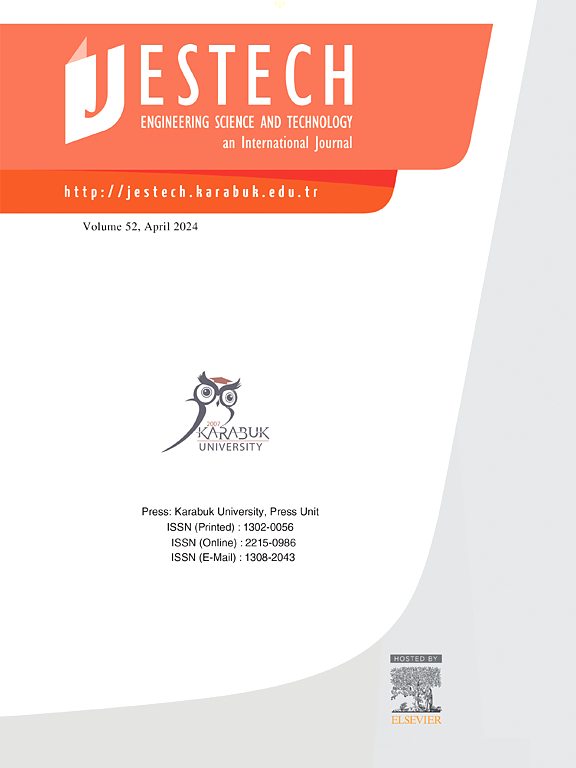迈向6G-IoT中的最后一英里连接:在大气衰减、应变和温度影响下,集成MIMO-FSO通信系统和FBG传感器
IF 5.1
2区 工程技术
Q1 ENGINEERING, MULTIDISCIPLINARY
Engineering Science and Technology-An International Journal-Jestech
Pub Date : 2025-01-30
DOI:10.1016/j.jestch.2025.101958
引用次数: 0
摘要
自由空间光通信(FSO)是一种先进的无线光通信技术,为第六代无线通信和物联网网络提供高速数据服务。针对开发开放环境下的6G物联网网络,本文分析了温度和应变对光纤光栅(FBG)传感器FSO通信链路的影响。FSO系统对温度变化很敏感,接收望远镜的位置可能会因机械应变而改变,从而影响大气的折射率,导致信号衰减和指向误差。目前的工作提出了一个模型,该模型集成了FBG传感器与FSO通道,用于同时测量应变和温度,以及克服严重信号衰减的补偿器。此外,还分析了大气衰减对FSO系统的影响。分析了弱、中、强湍流条件下的闪烁模型,并利用伽玛湍流模型的性能对MIMO FSO信道进行了观测。结果是在FSO链路与大气衰减的情况下观察到的,FBG传感器反映了接收器的指向误差,显示了捕获应变和温度参数的综合能力。对于10 Gb/s的数据传输,观察到多输入多输出(MIMO)-FSO技术的包含显着将比特误差从- 3.12494 dB降低到- 35.018 dB,并将信号功率从52.4 dBm增加到58.9 dBm,表明该集成策略适用于FSO通信与FBG传感器在6G-IoT应用中的最后一英里连接。本文章由计算机程序翻译,如有差异,请以英文原文为准。

Towards last-mile connectivity in 6G-IoT: An integrated MIMO-FSO communication system and FBG sensors under atmospheric attenuations, strain and temperature effects
Free-space optical (FSO) communication is an advanced wireless optical communication technology that provides high-speed data services for 6th-generation wireless communication and Internet of Things (IoT) networks. In light of developing a 6G IoT network in an open environment, this paper analyses the impact of temperature and strain on FSO communication links using Fiber Bragg Grating (FBG) sensors. FSO systems are sensitive to temperature variations, and the position of the receiving telescope can be altered by mechanical strain that can affect the refractive index of the atmosphere, leading to signal attenuation and pointing errors. The current work proposes a model that integrates FBG sensors with an FSO channel for simultaneous strain and temperature measurements and a compensator that overcomes severe signal attenuations. Also, the impact of atmospheric attenuations on FSO systems is analysed. Scintillation models for weak, moderate and strong turbulence conditions are analysed, and the performance of the gamma-gamma turbulence model has been used to observe the MIMO FSO channel. The results are observed for FSO links with the atmospheric attenuations with FBG sensors that reflect the pointing errors at the receiver, showing a comprehensive ability to capture strain and temperature parameters. For the transmission of 10 Gb/s data, it was observed that the inclusion of the Multiple input and multiple-output (MIMO)-FSO technique significantly reduces bit errors from −3.12494 dB to −35.018 dB and increase signal power from 52.4 dBm to 58.9 dBm, indicating the adaptability of this integrated strategy for FSO communication with FBG sensors for last mile connectivity in 6G-IoT applications.
求助全文
通过发布文献求助,成功后即可免费获取论文全文。
去求助
来源期刊

Engineering Science and Technology-An International Journal-Jestech
Materials Science-Electronic, Optical and Magnetic Materials
CiteScore
11.20
自引率
3.50%
发文量
153
审稿时长
22 days
期刊介绍:
Engineering Science and Technology, an International Journal (JESTECH) (formerly Technology), a peer-reviewed quarterly engineering journal, publishes both theoretical and experimental high quality papers of permanent interest, not previously published in journals, in the field of engineering and applied science which aims to promote the theory and practice of technology and engineering. In addition to peer-reviewed original research papers, the Editorial Board welcomes original research reports, state-of-the-art reviews and communications in the broadly defined field of engineering science and technology.
The scope of JESTECH includes a wide spectrum of subjects including:
-Electrical/Electronics and Computer Engineering (Biomedical Engineering and Instrumentation; Coding, Cryptography, and Information Protection; Communications, Networks, Mobile Computing and Distributed Systems; Compilers and Operating Systems; Computer Architecture, Parallel Processing, and Dependability; Computer Vision and Robotics; Control Theory; Electromagnetic Waves, Microwave Techniques and Antennas; Embedded Systems; Integrated Circuits, VLSI Design, Testing, and CAD; Microelectromechanical Systems; Microelectronics, and Electronic Devices and Circuits; Power, Energy and Energy Conversion Systems; Signal, Image, and Speech Processing)
-Mechanical and Civil Engineering (Automotive Technologies; Biomechanics; Construction Materials; Design and Manufacturing; Dynamics and Control; Energy Generation, Utilization, Conversion, and Storage; Fluid Mechanics and Hydraulics; Heat and Mass Transfer; Micro-Nano Sciences; Renewable and Sustainable Energy Technologies; Robotics and Mechatronics; Solid Mechanics and Structure; Thermal Sciences)
-Metallurgical and Materials Engineering (Advanced Materials Science; Biomaterials; Ceramic and Inorgnanic Materials; Electronic-Magnetic Materials; Energy and Environment; Materials Characterizastion; Metallurgy; Polymers and Nanocomposites)
 求助内容:
求助内容: 应助结果提醒方式:
应助结果提醒方式:


